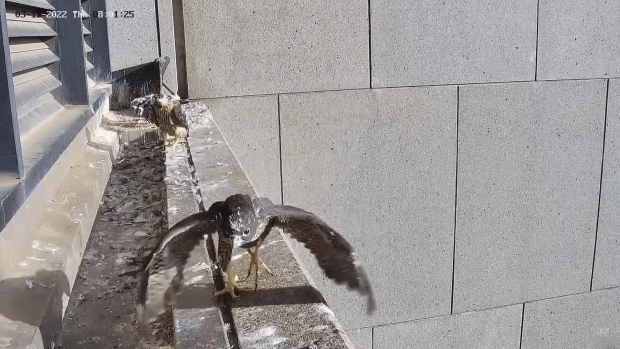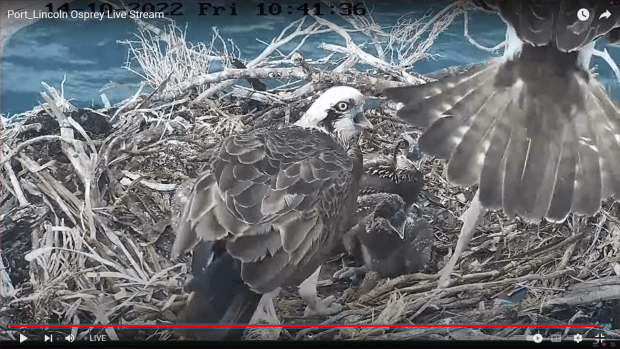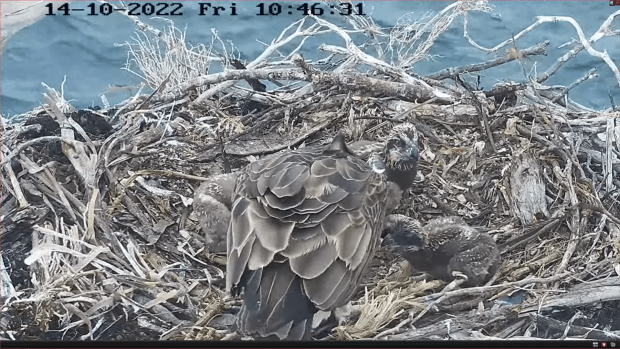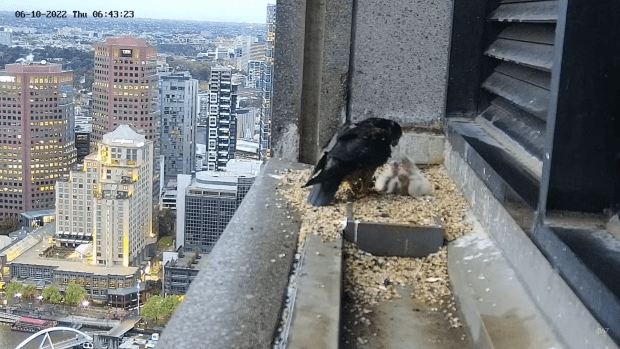3 November 2022
Good Morning Everyone,
Thank you for your very kind messages. I am phenomenally lucky to have such empathetic people in my life. The collective mourning of Middle is a way of healing our hearts and our minds. For many it will be some time when we can look at Big and not think of Little or Middle. The circumstances this year were very challenging to this Osprey family and it was not only the osplets that suffered from lack of fish but also, Mum and Dad. It was worrying watching Mum not have fish to eat. The water has calmed today and an enormous fish arrived early. Big and Mum ate for more than an hour and a half. The seas are calm and the weather is better.
You will, of course, notice that I say ‘she’ and I have always referred to Big as a female. Some wonder if it makes a difference on a nest if the first hatch is a big female. So, let me try to explain. If the entire clutch is female – and there were several Osprey nests in the UK this year with just females – Manton Bay at Rutland and Dyfi in Wales – there are no problems. If the clutch is all male such as that at Port Lincoln last year, the lads are angels. Put a big female at the head of a mixed clutch on a nest with problematic fish deliveries and well, you have trouble. The key phrase is ‘problematic fish deliveries.’ It can be as simple as only one fish arriving on a particular day mid-afternoon and immediately, the eldest female, who requires 50% more food (all females require more food to feather than the males) is alert that there might not be enough fish available to feed the entire family. In some instances, there are no problems with mixed clutches because the fish land on the nest, the feeding is extremely democratic, and well, life is good. If there is a problem, the first place to look is gender/birth order and a period of few fish being delivered. Because so few nests band and take DNA tests, it is impossible to say with 100% accuracy that the culprit is a large female first hatch but, overall, it appears that is the case.
It is very true. New kittens are a distraction. These two came on a day when I needed that, a wee break from the ospreys. (I highly recommend taking mental health time from the nests – it is very beneficial). These two are rescues. They were found as newborns along with their siblings and Mum. They went into foster care before they could be adopted. They are not related but, knock on wood, they are getting along splendidly.
This is Lewis. Named after Lewis Hamilton the race car driver because he zips around everywhere too fast.

This is Missey. She is a week older than Lewis, a really tiny fluffy girl. All that fur makes her look bigger than she is and she fooled Lewis right away, establishing her right to dominance. Lewis did not care! He just wants his food and his toys and some loving attention! Lewis enjoys seeing all the birds and squirrels in the garden and Missey could care less. She likes her cat tree and she has taken over the hidey-hole in it.

In the Mailbox:
Many wrote to ask if they were seeing things. ” Were there really fish left after Middle’s body was retrieved?”
The answer is ‘yes’. There is a standard practice by banders to leave fish on the nest after they remove the chicks from the nest and return them. Additionally, there were fish placed on the Port Lincoln barge nest just around 0906. You could see two hands. It is apparent that Port Lincoln applied for and was given permission to supplement the fish for the nest. Sadly, those fish came late. Hopefully permission can be given to PLO for eventualities, a blanket permission if this situation presents itself in the future.
The Australian Nest and Scrapes:
367 Collins Street. The Melbourne Four. Look at that eyas below. There are only a couple of dandelions on the head and wing, reminders of its fluffy youth. What a beautiful falcon. It is the 4th of November in Melbourne. If the scrape at Charles Sturt University in Orange goes on fledge watch around the 12th, this means that we are entering fledge watch at the Melbourne scrape for the eldest tomorrow. I must check that!
‘H’ reports that there were at least two prey drops on camera and one off yesterday. The eyases have also been chewing on all the leftovers in the scrape.
And if you are wondering, no one cleans up the area. The wind and the rain between the end of this season and the beginning of next seem to do a good job. Falcons also like to know that wherever they raise their eyases is a good prey area so if they see a scrape like this one, well, they will know in an instant. That said, you will notice, that when the eyases are quite tiny the Mum will keep the scrape pristine for a bit. It helps to detract predators if there are any.



Wow. Look at those wings!


Seriously adorable.

Mum deserves to be proud. Look at her four ‘babies’. They are nearly ready to fly off the ledge and start learning how to hunt their own prey. Soon – if they have not already started – Mum and Dad will do flying lessons, some with and some without prey, to lure the eyases into fledging. There is still some time to go. They need their fluff gone!
Do you remember when we worried so much about this particular scrape? I have almost forgotten Mum leaving these wee ones in the middle of the day in the Melbourne heat before they could stomp down to the other end. They survived. Mum and Dad did well – first time parents.
Rubus and Indigo are precious. Fledge watch will start for Indigo on the 12th of November. I simply hope that Rubus doesn’t do what he always does and copy her immediately. He will not be ready.




The only prey so far at Orange is the early delivery of that large prey item. It is now 1439. As the chicks get older, the number of feedings drops considerably because the eyases can eat more and more at one sitting. I bet they would love a parent to fly in with a nice fat pigeon right about now.

One of the most tender moments on any nest is when one of the adults feeds the other. In this case, this morning Mum fed Dad at Port Lincoln. He brought in a huge fish and Mum and Big had been eating for an hour and a half. What a wonderful way to thank your mate. And it was more than one bite!
We need to pause and imagine just how hungry Mum was. I need to remind myself of this. How many times did we see her feed almost every bite of fish to the osplets? or just to Big without having more than a handful of bites herself. She must stay healthy and the same goes for Dad. I often say it is like flying in the plane, ‘Put the oxygen mask over the adult before the child.’ Mum did not always do that and there were plenty of times that Dad came to the nest and there was no leftover fish.
Both of these parents are mourning the loss of their chick. They don’t have the liberty to take a mental health day like I did, they must be there and carry on, making sure Big fledges.

The arrival of the big fish on the nest this morning.

It was a lot of fish and would keep Big until tomorrow if another does not come on the nest today.

Port Lincoln has expressed some concern that other chicks were lost on unmonitored nests during this period of bad weather where the males were unable to bring in enough fish.
Let us all hope collectively that permissions to assist with fish come in a timely manner or a blanket permission.
Migration News:
Bonus has found a good place to rest and feed now that he has left Greece. He is currently in Konya Province in Turkey just north of Lake Seydisehir.


Waba is feeding along the Nile River in Egypt.


Making News Elsewhere:
I am finishing reading Bowland Beth, the story of an extraordinary Hen Harrier who died way too young. A second book, The Hen Harrier’s Year by Ian Carter and Dan Powell (newly released) arrived today. I am very interested in the topic of the Hen Harrier because they are becoming more rare than they already are because of persecution by grouse hunting community and the games keepers. In the Foreword to the book, Roger Riddington states, ‘In recent years the Hen Harrier has become the de facto flagship species for the birding community in its stance against raptor persecution.’ While the Hen Harriers are, in particular, being shot with their populations on the knife edge, it is also other raptors that we should be concerned with as well – such as the White-tailed Eagle.
A recent report talks about the ghastly people who are these games keepers and how sadistic they are. It is good that the Scottish government has taken a stance and the prison terms will be such that they might deter the practice. The real way is to outlaw hunts. Fox, Red Grouse, you name it…outlaw them.
Something to feast your eyes on – patterns created by our feathered friends in flight.

What if there are no birds to create the images the artist depicted above? What if the climate is heating faster and faster and warming the seas quicker? There are many sobering questions for humans who have caused the destruction of our planet and the myriad of challenges for our beloved birds (and all wildlife). The warnings of our planet heating faster than anticipated are beginning to make headlines in certain papers.

There is also news coming in regarding SE29 from the Sea Eagle Cam. There is no news on SE30.
November 2 : news from the vet caring for SE29 : today SE29 has moved into a slightly larger room that can be monitored with CCTV -doing as well as can be expected , everything is stable at this point.
Harriet and M15 on the branches after working hard on rebuilding their nest destroyed by Hurricane Ian. If they don’t put a smile on your face, I honestly do not know what will!



The first Bald Eagle egg of the year has been laid in Florida. That honour goes to the nest of Superbeaks, Muhlady and Pepe. The first egg of the Royal Albatross season has been laid at Taiaroa Head. Those parents are GK (Green Black) and BKW (Blue Black White).
Remember to send some of the names you came up with for the Alphabet Game by midnight tonight! E-mail is: maryasteggles@outlook.com
Thank you so much for being with me this morning and being the caring community that you are. Please take care as we all collectively heal. See you tomorrow!
Thank you to the following for their posts, their videos and/or their streaming cams where I took my screen captures: ‘H’, Port Lincoln Ospreys, 367 Collins Street by Mirvac, Charles Sturt Falcon Cam and Cilla Kinross, SWFlorida Eagles and D Pritchett, The Guardian, and those great people at the Looduskalender Forum.













































































































































































































